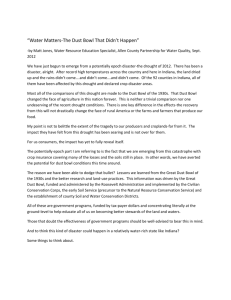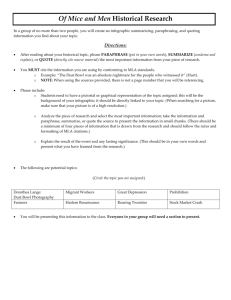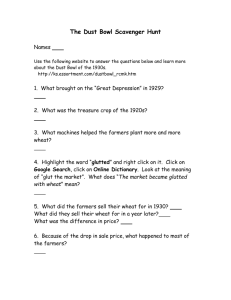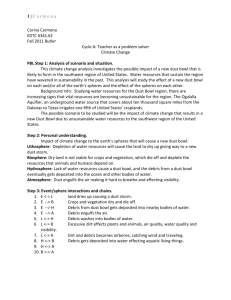Student draws at least one accurate conclusion about the Dust Bowl.
advertisement
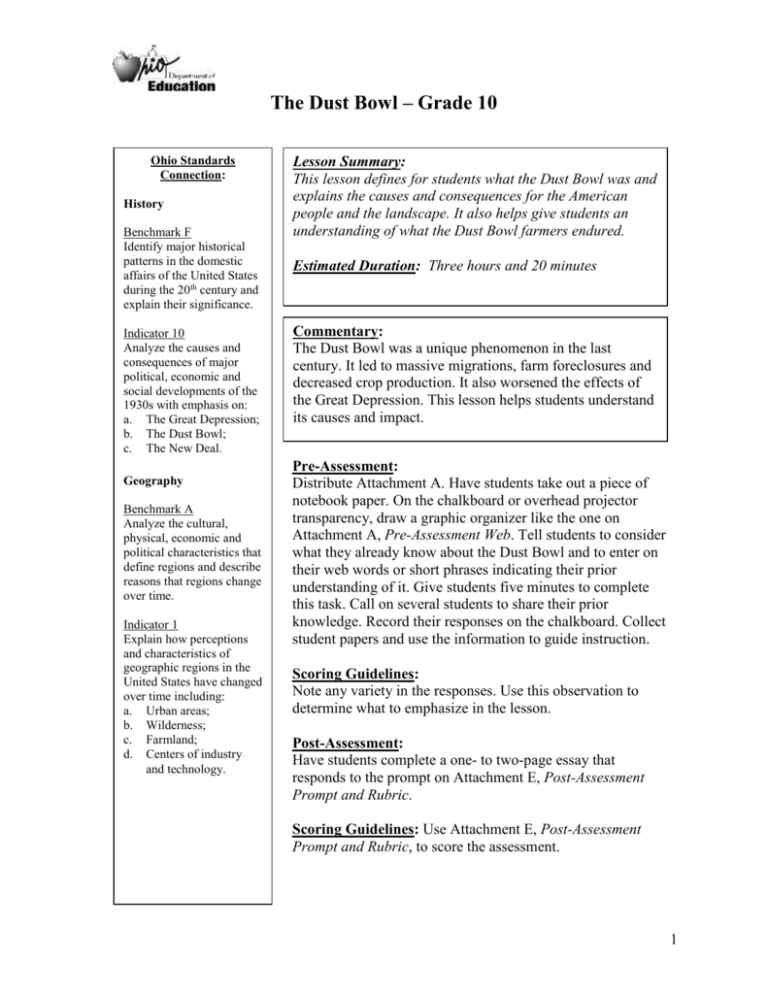
The Dust Bowl – Grade 10 Ohio Standards Connection: History Benchmark F Identify major historical patterns in the domestic affairs of the United States during the 20th century and explain their significance. Indicator 10 Analyze the causes and consequences of major political, economic and social developments of the 1930s with emphasis on: a. The Great Depression; b. The Dust Bowl; c. The New Deal. Geography Benchmark A Analyze the cultural, physical, economic and political characteristics that define regions and describe reasons that regions change over time. Indicator 1 Explain how perceptions and characteristics of geographic regions in the United States have changed over time including: a. Urban areas; b. Wilderness; c. Farmland; d. Centers of industry and technology. Lesson Summary: This lesson defines for students what the Dust Bowl was and explains the causes and consequences for the American people and the landscape. It also helps give students an understanding of what the Dust Bowl farmers endured. Estimated Duration: Three hours and 20 minutes Commentary: The Dust Bowl was a unique phenomenon in the last century. It led to massive migrations, farm foreclosures and decreased crop production. It also worsened the effects of the Great Depression. This lesson helps students understand its causes and impact. Pre-Assessment: Distribute Attachment A. Have students take out a piece of notebook paper. On the chalkboard or overhead projector transparency, draw a graphic organizer like the one on Attachment A, Pre-Assessment Web. Tell students to consider what they already know about the Dust Bowl and to enter on their web words or short phrases indicating their prior understanding of it. Give students five minutes to complete this task. Call on several students to share their prior knowledge. Record their responses on the chalkboard. Collect student papers and use the information to guide instruction. Scoring Guidelines: Note any variety in the responses. Use this observation to determine what to emphasize in the lesson. Post-Assessment: Have students complete a one- to two-page essay that responds to the prompt on Attachment E, Post-Assessment Prompt and Rubric. Scoring Guidelines: Use Attachment E, Post-Assessment Prompt and Rubric, to score the assessment. 1 The Dust Bowl – Grade 10 Instructional Procedures: Day One 1. Hand out Attachment A, Pre-Assessment Web. Conduct the pre-assessment activity and discuss. 2. Distribute Attachment B, Photograph Captions. 3. Display five photos from the Dust Bowl era. 4. Instruct students to write a descriptive caption for each photo as it is displayed. Give them several minutes to create each caption. Then, have several students share their captions with the class. Have the class decide which one is the most appropriate for the photo. Repeat this for each of the five pictures. 5. At the end of the activity, have students write a one- or two-paragraph response to the photos. What feelings do the photos elicit? Day Two 6. Assign students to work in pairs. 7. Distribute Attachment C, Dust Bowl Diagram. 8. Have students use their textbooks and/or the Internet to complete the diagram. Students should pay special attention to relationships they see between the causes and consequences of the Dust Bowl. 9. Toward the end of the period, have each set of students report back to the class. 10. On a transparency copy of Attachment C, record student answers for causes, consequences and conclusions. Tell students to add to their diagrams any correct answers that they did not already have recorded. 11. Be sure to focus on the relationships between the causes and consequences of the Dust Bowl. Students may have a hard time with this section. Day Three 12. Lead a formal discussion or lecture that emphasizes the causes, consequences and conclusions regarding the Dust Bowl. Be sure to point out how the perception and characteristics of the region changed over time. Use Attachment F, Sample Answers, and any other resources available to inform the discussion or lecture. Day Four 13. Distribute Attachment E, Post-Assessment Prompt and Rubric. 14. Provide time in class for students to complete the post-assessment. Differentiated Instructional Support: Instruction is differentiated according to learner needs, to help all learners either meet the intent of the specified indicator(s) or, if the indicator is already met, to advance beyond the specified indicator(s). Provide peer note-takers for the student. Provide extended time to students working toward the standard. Allow students to use their notes as they write the post-assessment essay. 2 The Dust Bowl – Grade 10 Extensions: Have students write a letter from the perspective of a Dust Bowl survivor who lives in Oklahoma City, Oklahoma. The letter should be dated January 1, 1935. Divide the class into groups of three or four. Using photographs of the Dust Bowl region, assign each group one photograph. Have students evaluate the photo based on the following criteria: layout; point of view; intended audience; intended message; overall impact. Have students explore political, economic and social issues and trends regarding poverty in America today. Have students research this topic in the learning resource center, library or computer lab. Have students write journal entries comparing conditions of poverty in America today with conditions of poverty during the Great Depression. Homework Options and Home Connections: Have students interview any friends of the family who lived during the time of the Dust Bowl and ask about their most vivid memories of that period. Interdisciplinary Connections: Fine Arts: Music Have students listen to a song about the Dust Bowl and write their own lyrics to the song, based on their understanding of changes to the perception of the region during the 1930s. Materials and Resources: The inclusion of a specific resource in any lesson formulated by the Ohio Department of Education should not be interpreted as an endorsement of that particular resource, or any of its contents, by the Ohio Department of Education. The Ohio Department of Education does not endorse any particular resource. The Web addresses listed are for a given site’s main page, therefore, it may be necessary to search within that site to find the specific information required for a given lesson. Please note that information published on the Internet changes over time, therefore the links provided may no longer contain the specific information related to a given lesson. Teachers are advised to preview all sites before using them with students. For the teacher: Chalkboard, overhead projector and transparencies, Dust Bowl photographs. For the students: Writing supplies. Vocabulary: migrant workers Dust Bowl black blizzards Okies 3 The Dust Bowl – Grade 10 Technology Connections: Photographs and music of this era may be obtained from the Library of Congress American Memory Web site: http://memory.loc.gov. Research Connections: Marzano, R. et al. Classroom Instruction that Works: Research-Based Strategies for Increasing Student Achievement, Alexandria, VA: Association for Supervision and Curriculum Development, 2001. Note taking is a powerful skill that helps students identify important aspects of what they are learning. General Tips: This lesson can be used to emphasize points made about the effects of the Great Depression from the previous lesson. This lesson covers a particularly noteworthy set of circumstances illustrating the difficult times experienced across the country. Attachments: Attachment A, Pre-Assessment Web Attachment B, Photograph Captions Attachment C, Dust Bowl Diagram Attachment D, Dust Bowl Diagram Key Attachment E, Post-Assessment Prompt and Rubric Attachment F, Sample Answers 4 The Dust Bowl – Grade 10 5 The Dust Bowl – Grade 10 Attachment B Photograph Captions Photograph caption #1: Photograph caption #2: Photograph caption #3: Photograph caption #4: Photograph caption #5: Student reaction to photos: 6 The Dust Bowl – Grade 10 7 The Dust Bowl – Grade 10 8 The Dust Bowl – Grade 10 Attachment E Post-Assessment Prompt and Rubric Directions: In a one- to two-page essay, analyze three causes and three consequences of the Dust Bowl. Be sure to mention three conclusions that can be drawn from your analysis. Also, explain how perceptions and characteristics of this geographic region changed over time. 3 Student provides Causes accurate analysis of at least three causes of the Dust Bowl. Student Consequences provides accurate analysis of at least three consequences of the Dust Bowl. Student draws at least three Conclusions accurate conclusions about the Dust Bowl. 2 Student provides accurate analysis of at least two causes of the Dust Bowl. Student provides accurate analysis of at least two consequences of the Dust Bowl. Student draws at least two accurate conclusions about the Dust Bowl. 1 Student provides accurate analysis of at least one cause of the Dust Bowl. Student provides accurate analysis of at least one consequence of the Dust Bowl. Student draws at least one accurate conclusion about the Dust Bowl. 0 Student provides inaccurate or no analysis of the causes of the Dust Bowl. Student provides inaccurate or no analysis of the consequences of the Dust Bowl. Student draws inaccurate or no conclusions about the Dust Bowl. Student provides accurate explanations of both the changes in perception and characteristics of the Dust Bowl. Student provides an accurate explanation of either the changes in perception or characteristics of the Dust Bowl. Student provides somewhat accurate explanations of both the changes in perception and characteristics of the Dust Bowl. Student provides inaccurate or no explanation of the changes in perception and characteristics of the Dust Bowl. Explanation of changes 9 The Dust Bowl – Grade 10 Attachment F Sample Answers The Dust Bowl was the region of land in the Great Plains extending from Texas to North Dakota. By the early 1930s, drought combined with millions of grassless acres of prairie land created an environment in the Great Plains where the soil was dry. The Dust Bowl got its name because the land had few trees or plants to hold down the soil; therefore, dust from wind storms traveled hundreds of miles. Four causes of the Dust Bowl were: The land was unsuitable for farming because it had been exhausted from the overproduction of crops; Weather pattern changes caused this region to have severe droughts; There were harsh windstorms. The drought and the windstorms caused the characteristics of this region to change; There was little ground cover to hold the soil during windstorms. Five consequences of the Dust Bowl were: The drought caused crop losses. Wheat production was down; Due to crop losses, many farmers could not pay their debts and lost their farms due to foreclosure. Nearly 60 percent of Dust Bowl families lost their farms; Dust storms led to massive cleanups; People migrated to other regions because the land was unsuitable for farming; The migration from this region caused the population of other states to expand. Possible conclusions that might be drawn from the analysis include: 1930’s weather patterns over the Great Plains caused significant disruptions in economic activity. Farming practices during the 1920’s prompted the development of the Dust Bowl. The conditions of the Dust Bowl changed the popular perception of the area centered on the Oklahoma panhandle from a major wheat-growing area to an area of desolation. Geographic and economic conditions impact migration and population patterns. The challenges resulting from the Dust Bowl contributed to the growth of the federal government as it created programs to address agricultural distress. The perception of this region changed from a valuable farming area to an area of desolation. Formerly a major wheat-producing area, the area of the Dust Bowl became barren. The farmers of the Dust Bowl struggled to survive like many other Americans during the Great Depression due to the changing geographic factors. 10


